 |
 |
 |
| |
ART Started in Primary Infection May
"Block Immunologic Storm" in French OPTIPRIM
|
| |
| |
Download the PDF here
7th IAS Conference on HIV Pathogenesis, Treatment and Prevention, June 30-July 3, 2013, Kuala Lumpur
Mark Mascolini
Three- or five- drug antiretroviral therapy (ART) during primary HIV infection lowered HIV DNA levels in peripheral blood mononuclear cells (PBMCs) more than 20-fold in 12 months and pushed HIV DNA loads below 200 copies per million PBMCs in half of OPTIPRIM study participants [1]. Median CD4 count rose by 235 cells through 12 months of therapy.
Rampant immune activation during primary HIV infection correlates with HIV DNA in PBMCs--the higher the proportion of activated CD8 cells, the higher the HIV DNA load [2]. A previous cohort-based French study, VISCONTI, found that starting ART during primary HIV infection promotes a steep drop in PBMC HIV DNA [3].
To pursue this evidence that treatment during primary infection "could block the virological and immunological storm and limit the establishment of HIV reservoirs," French ANRS investigators conducted the OPTIPRIM trial. From May 2010 to July 2011, they recruited people with acute or early HIV-1 infection marked by (1) a Western blot positive for 4 or fewer antibodies, (2) a plasma viral load above 50 copies, and (3) symptomatic primary infection or asymptomatic primary infection with a CD4 count below 500.
The primary endpoint is HIV DNA level in PBMCs after 24 months of treatment with five-drug ART versus three-drug ART. The five-drug regimen included once-daily darunavir/ritonavir and tenofovir/emtricitabine plus twice-daily raltegravir and maraviroc. The three-drug combination included darunavir/ritonavir plus tenofovir/emtricitabine. After 24 months of therapy, treatment will stop. At IAS 2013 the investigators reported combined results of the two study arms at month 12.
Eighty-three of 90 study participants were men, and median age of the study group stood at 35.5 years (interquartile range [IQR] 28 to 44). Eighty-seven participants had symptomatic primary infection. Median time from estimated date of HIV infection measured 35 days, and 43% of participants had a Western blot positive for 1 or no antibodies. Median initial HIV RNA in plasma stood at 5.4 log (IQR 4.9 to 5.8), median HIV DNA in PBMCs at 3.6 log (about 4000 copies, IQR 3.4 to 4.1), and median CD4 count at 472 (IQR 368 to 640).
Two people dropped out soon after enrollment. Two other participants, both in the 3-drug arm, had a serious adverse event--lipodystrophy in one and pancreatitis in the other. Through 12 months of treatment median CD4 count in the combined study arms rose from 472 to 707. Median CD4/CD8 ratio reached 1.13 at month 12 (IQR 0.87 to 1.38). A ratio above 1 is considered normal.
In the combined arms, proportions of study participants with plasma HIV RNA below 50 copies climbed from 8% at month 1 to 50% at month 3, 83% at month 6, and 93% at month 12. HIV DNA fell by a median 1.34 log10 copies per million PBMCs (about 22-fold, IQR -1.56 to -1.02) in 67 people with HIV DNA measured at month 12. That rate exceeds drops of 0.81 log in the 325-person ANRS PRIMO cohort and 1.1 log in the 10-country, 56-person Quest cohort [4]. In the study abstract, the researchers reported that 20 of 39 people (51.3%) who had reached month 12 at that point had an HIV DNA load below 200 copies per million PBMCs.
The OPTIPRIM team concluded that starting antiretroviral therapy during primary infection has a greater impact on the PBMC reservoir than starting during chronic infection. They suggested that the immunologic effects recorded so far probably reflect early protection of memory T cells with a long half-life. The researchers stressed that tolerance and adherence to both regimens has been excellent.
The French investigators proposed that "treating patients at the earliest time in primary infection induces a strong decrease of HIV reservoirs and might increase [the] likelihood of post-treatment control."
References
1. Cheret A, Nembot G, Avettand-Fenoel V, et al. Impact of 12 months HAART on cell-associated HIV-DNA in acute primary HIV-1 infection in the OPTIPRIM-ANRS 147 trial. 7th IAS Conference on HIV Pathogenesis, Treatment and Prevention, June 30-July 3, 2013, Kuala Lumpur. Abstract WEAB0101.
2. Weiss L, Chevalier M, Assoumou L, et al. T cell activation positively correlates with cell-associated HIV-DNA level in PBMCs in viremic patients with acute or chronic HIV-1 infection. 7th IAS Conference on HIV Pathogenesis, Treatment and Prevention, June 30-July 3, 2013, Kuala Lumpur. Abstract MOPDA0106. http://pag.ias2013.org/EPosterHandler.axd?aid=1533
3. Saez-Cirion A, Bacchus C, Hocqueloux L, et al. Post-treatment HIV-1 controllers with a long-term virological remission after the interruption of early initiated antiretroviral therapy ANRS VISCONTI Study. PLoS Pathog. 2013;9:e1003211. http://www.natap.org/2013/HIV/031513_02.htm
4. Hoen B, Cooper DA, Lampe FC, et al. Predictors of virological outcome and safety in primary HIV type 1-infected patients initiating quadruple antiretroviral therapy: QUEST GW PROB3005. Clin Infect Dis. 2007;45:381-390. http://cid.oxfordjournals.org/content/45/3/381.long
French prospective PRIMO Cohort - pdf attached
- Clinical Infectious Diseases 2006
Cecile Goujard,1,3 Mojgan Bonarek,5 Laurence Meyer,2 Fabrice Bonnet,5 Marie-Laure Chaix,4 Christiane Deveau,2
Martine Sinet,3 Julie Galimand,4 Jean-Francois Delfraissy,1,3 Alain Venet,3 Christine Rouzioux,4 Philippe Morlat,5 and the Agence Nationale de Recherche sur le Sida PRIMO Study Groupa
"The HIV DNA level in PBMCs provides an estimate of the cellular HIV reservoir, which is established soon after infection [36, 37]. We found that HIV DNA level was predictive of the risk of progression, independently of CD4 cell count and HIV RNA level. This is consistent with previous studies showing that HIV DNA level is an important predictor of CD4 cell loss, AIDS, and death, both in patients with recent or chronic infection."
"An HIV DNA level >3.4 log10 copies/106 PBMCs (corresponding to the 66th percentile value) was associated with a 62% risk of progression at 2 years (95% CI, 44%-80%), compared with 13% (95% CI, 2%-23%) among patients with values <2.9 log10 copies/106 PBMCs (corresponding to the 33rd percentile value)."
"To better define the respective impacts of the CD4 cell count and HIV DNA level, we also made Kaplan-Meier estimates for patients with values greater than and less than the overall baseline median CD4 cell count (628 cells/mm3); patients in each subgroup were further stratified according to the median HIV DNA level (3.2 log10 copies/106 PBMCs). The risk of progression was very low when the CD4 cell count was >628 cells/mm3, regardless of the HIV DNA level (figure 3A). When the CD4 cell count was ≤628 cells/mm3 (figure 3B), a high HIV DNA level added significant weight to the predictive value of the CD4 cell count. The estimated risk of progression among these patients within the first 2 years ranged from 41% (95% CI, 21%-60%) among those with a HIV DNA level <3.2 log10 copies/106 PBMCs to 83% (95% CI, 67%-99%) among those with higher HIV DNA levels (P = .006, by log rank test)."
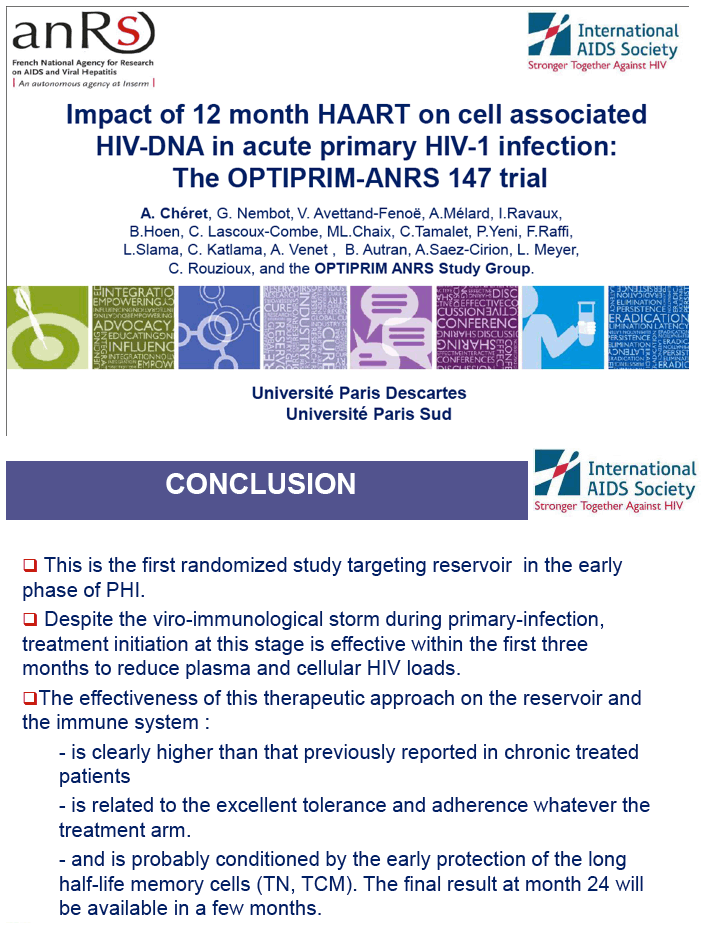
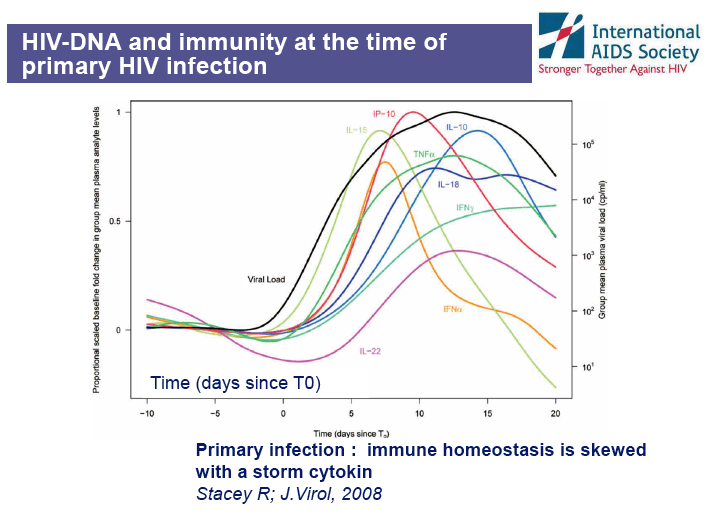
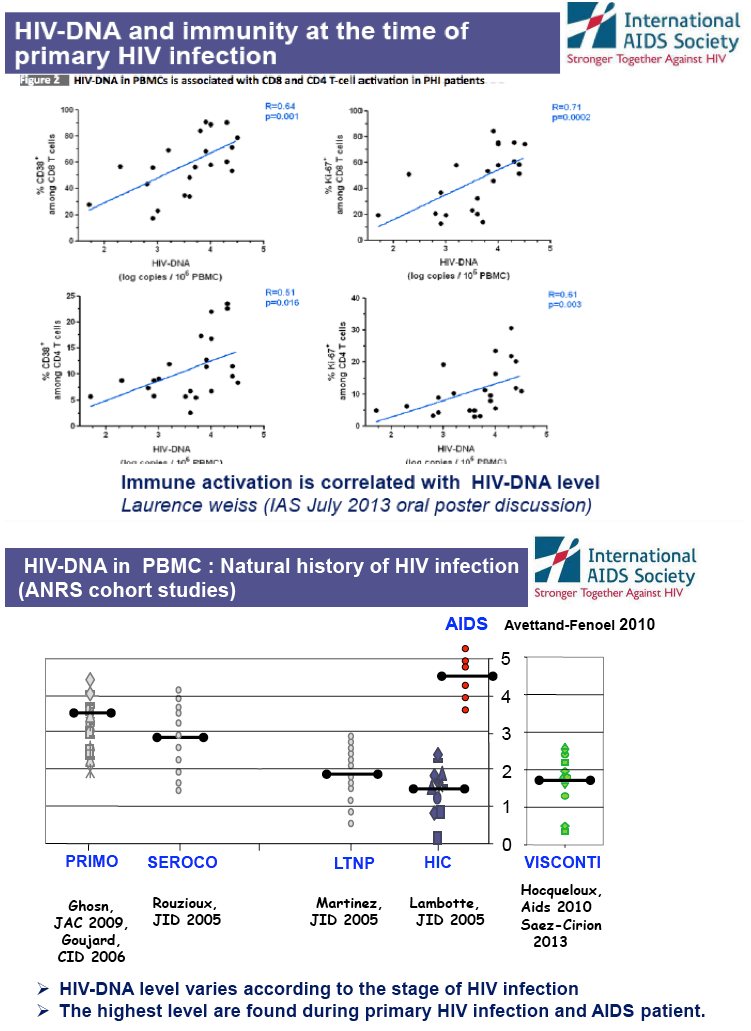
IAS: In chronically HIV-1-infected patients long-term antiretroviral therapy initiated above 500 CD4/mm3 achieves better HIV-1 reservoirs' depletion (HIV-DNA) and T cell count restoration - (07/05/13) Hoqueloux IAS
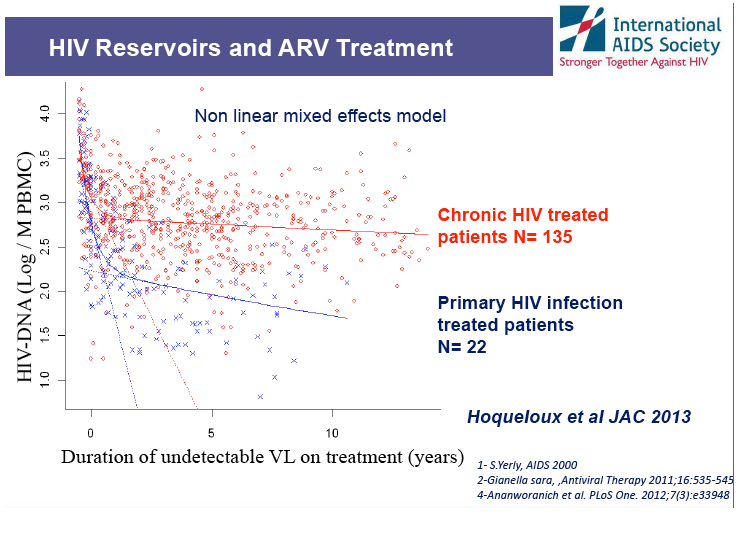
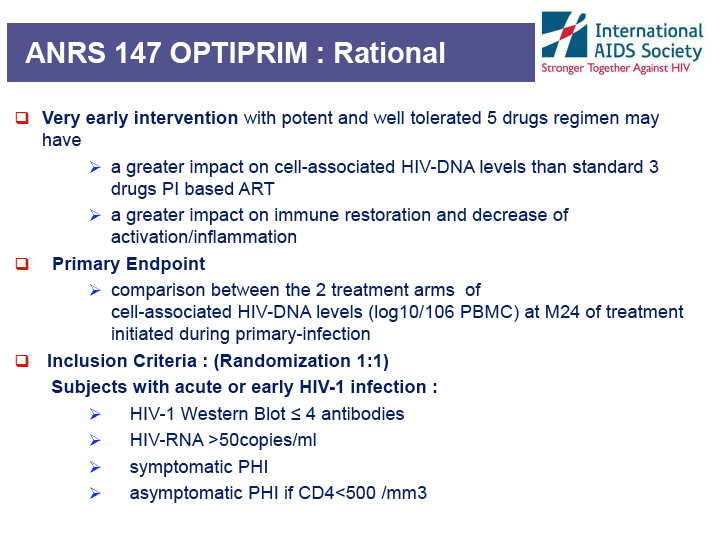
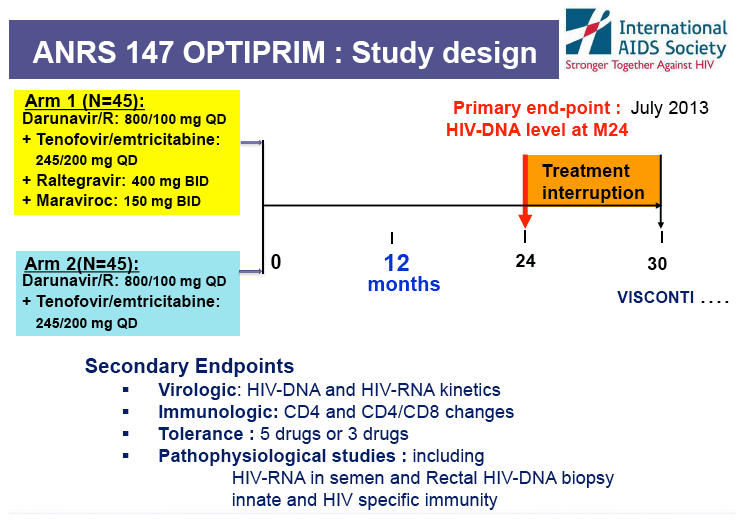
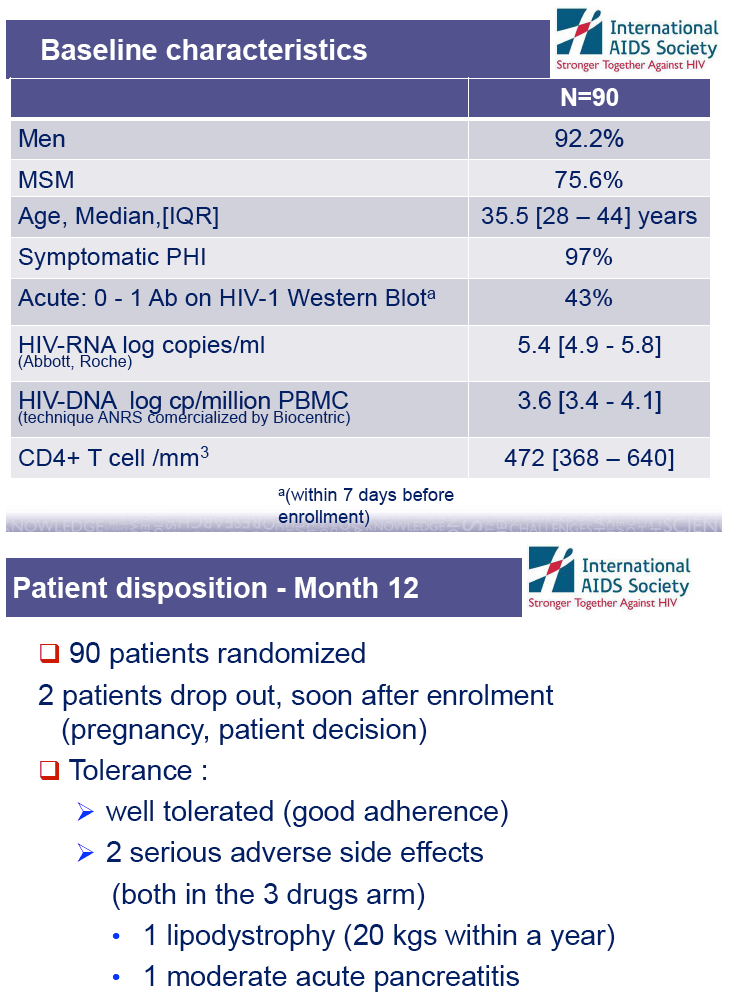
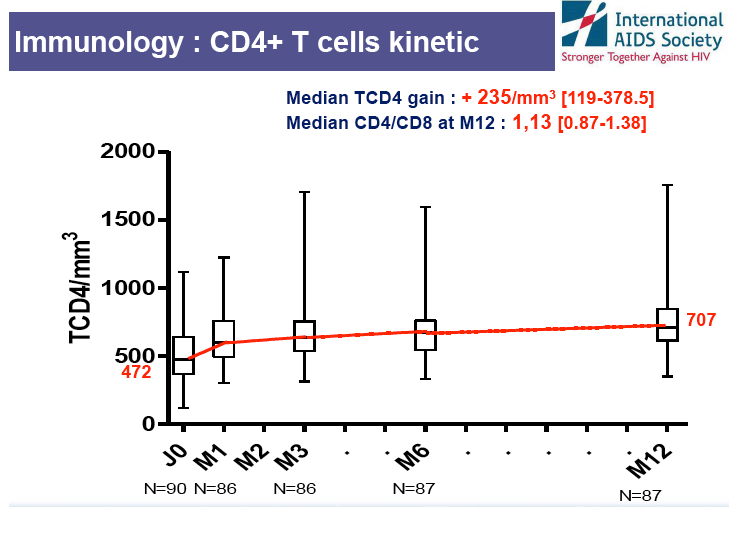
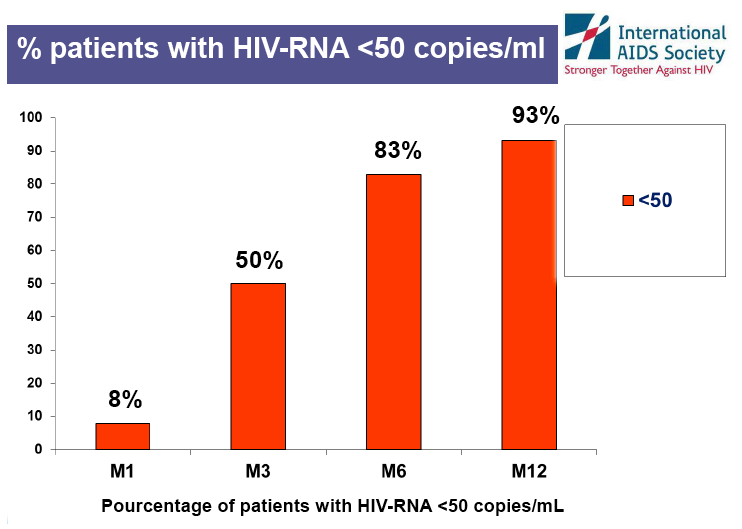
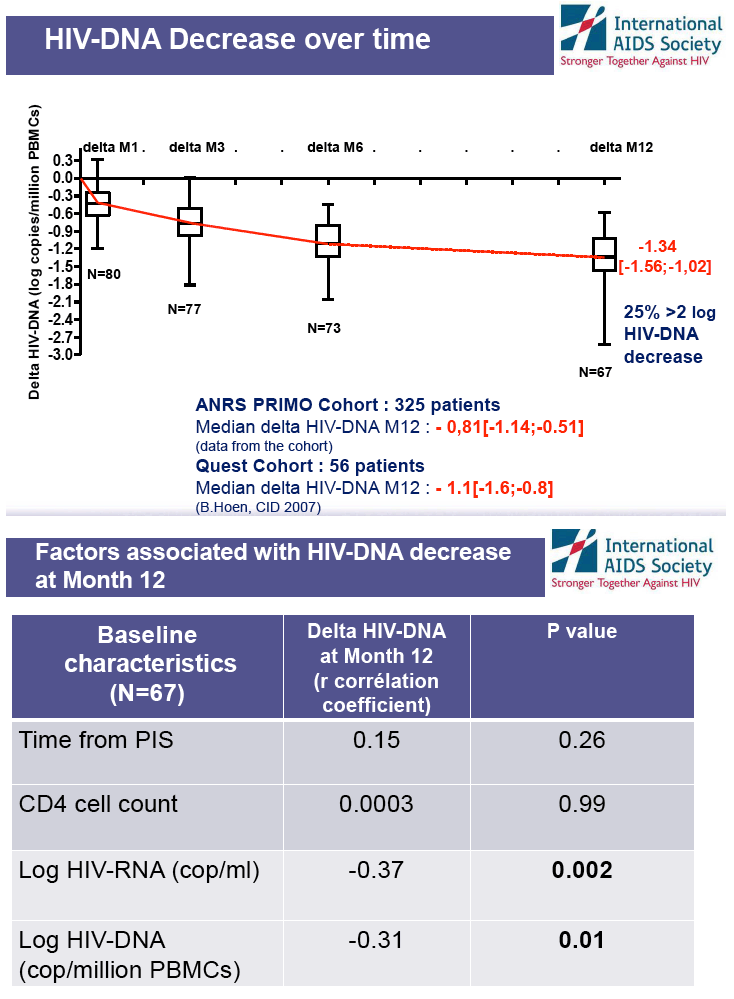
Plosone May 2013 publication:
http://www.plosone.org/article/info:doi/10.1371/journal.pone.0064219
"A better understanding of the initial sequence of events resulting in the early spread of HIV-1 and the constitution of the HIV reservoir in primary HIV-1 infection is essential for defining eradication strategies leading to an HIV cure. In our study, we demonstrated that only a month after infection, a single HIV-1 cluster is massively distributed within resting naive and various memory CD4 cell subsets, and that the relative contribution of each subset to the whole infected CD4 cell compartment reflects the skewed immune homeostasis at this early stage of PHI. This clonal HIV was inducible in all resting CD4 T-cell subsets, confirming the actual contribution of those cells as a HIV reservoir, as previously defined [1]. The flexibility of viral production according to subsets suggests that subsets activation and differentiation, but not viral diversity, determine the relative subsets contribution to the HIV reservoir."
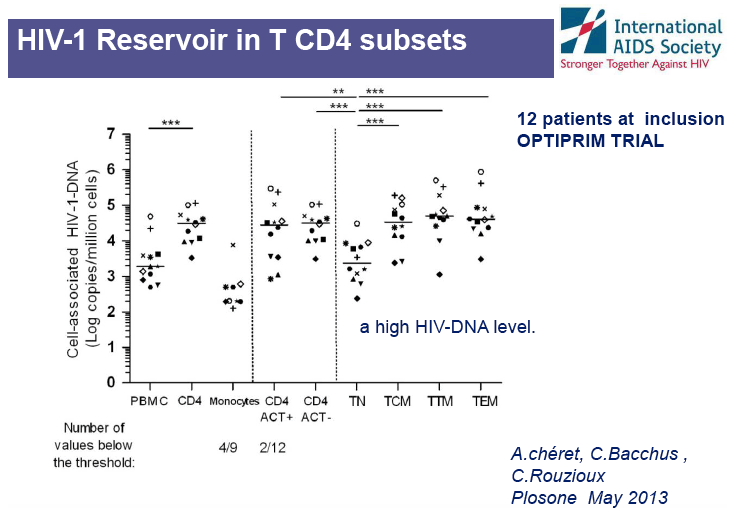
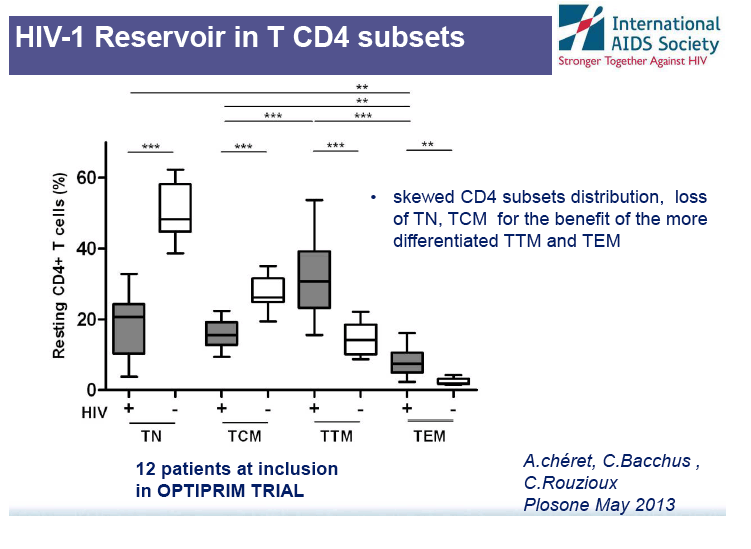
|
| |
|
 |
 |
|
|